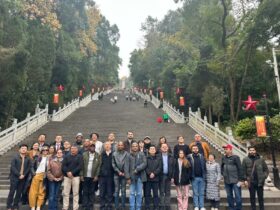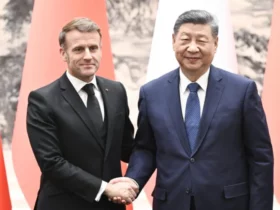Most people see China as anything but environmentalist, having for some time been one of the most polluted countries on earth. Images in the media are often heart-wrenching, children wearing pollution masks while their parents go through the day more or less helpless to protect them, all while the Chinese government continues to push mass-industrialization for profit and development.
While these melancholy scenes tell part of the truth, they can also significantly misrepresent the broader picture of what is happening in China today, and, like many purposeful misrepresentations, there are political rather than moral motivations behind their dissemination. While China is demonized, ridiculed, and vilified in the mass media on a daily basis for a variety of alleged offenses, accusations that the government is dragging environmental catastrophe rank among the most common and unquestioned attacks. If we are able move past the cliches and turn our attention to the country’s changing environmental policies, we will see a very different image of contemporary China, a country on the forefront of green technology and environmental policy.

Quartz media ran a story with the headline“One city in China has more electric buses than all of America’s biggest cities have busses,” this January showcasing a startling fact that likely came as a surprise to most readers. At the end of last year, Shenzhen’s transport commission announced that it had transitioned 16,359 buses to all-electric models. This is a larger number of buses than there are in almost all major US cities, including NYC, LA, NJ, Toronto and Chicago. The Chinese city’s 17,000 taxis are next, with 63% already running on electric
China has also built the world’s largest air purifier, which stands at 100 meters tall. Several people in Xian told the South China Morning Post they had noticed a significant difference since the tower started operating. A manager at a restaurant about 1km (0.62 miles) northwest of the facility said that there had been an improvement in air quality over the winter, despite that she was initially unaware of the tower’s purpose. A student studying environmental science at Shaanxi Normal University (also located a few hundred meters from the tower) said the improvement was noticeable.“I can’t help looking at the tower each time I pass. It’s very tall, very eye-catching, but it’s also very quiet. I can’t hear any wind going in or out,” she said. “The air quality did improve. I have no doubt about that.”
These serious measures in defense of the environment are unfortunately not being pursued by all major world powers. As China approaches super-power-status, it has been showing the world how significantly it will differ from other major world powers.
While US troops stationed around the world often bring terror and destruction, China recently announced that 60,000 soldiers and officers from the People’s Liberation Army will be reassigned to reforestation. The initiative is part of China’s plan to plant at least 84,000 square kilometers (32,400 square miles) of trees by the end of the year, which is roughly equivalent to the size of Ireland. The area was strategically placed around the perimeter of Beijing, China’s largest and most pollution-producing industrial center. Pollution in Beijing fell a whopping 53 percent from 2016-2017 according to Greenpeace. The non-government environmental organization also estimated that lower pollution levels resulted in 160,000 fewer premature deaths across the country in 2017.
When comparing the United States and China, it is crucial to keep in mind some important contextual factors. For the last few years, the US has been investing billions of dollars into the environmentally disastrous method of oil and natural gas extraction known as fracking. Fracking takes billions of gallons of public water and shoots them into the ground in a pressurized stream to push out and extract fossil fuels. This method is being used despite that numerous places in the US are experiencing severe water shortages and droughts.

Once again, China has a different way of doing things. Beijing’s water policy is exemplified by the “sponge city” initiative. Launched in 2015 in 16 cities, the initiative seeks to reduce the intensity of rainwater runoff by enhancing and distributing collection methods across targeted areas. The resulting groundwater replenishment increases the availability of water for various uses. This approach not only reduces flooding but also enhances water security.
China is also fighting the global climate crisis with another creative initiative– the world’s first “Forest City” is already under construction, promising to clean up the environment in the country’s dense urban centers. Covered in trees and greenery, these cities will absorb nearly 10,000 tons of CO2 and 57 tons of pollutants yearly, producing 900 tons of oxygen.
China has also commissioned the world’s first hydrogen tram, the first zero-emission electric cargo ship, a solar-powered highway, a floating solar farm, including the world’s largest which stretches over 10 square miles. A recent report by the Independent claims that all cars in China will be electric by 2030. Meanwhile, the United States government continues to cry foul against fossil-fuel alternatives do to lucrative nature of the coal industry.
China is also the world’s largest installer of clean energy, reaching a record 3.6 million jobs in renewable energy last year, while the US trailed behind with 777,000, according to the International Renewable Energy Agency.
The People’s Republic of China is leading the way in protecting the environment and reversing the effects of global climate change through rational and effective state planning. Socialist leaning governments such as Cuba, Venezuela and Bolivia are all following suit with similar progressive efforts.
Many environmentalists in the United States reject China as a positive example of anything, but especially in terms of the environment. While not perfect by any means, China has made tremendous strides to ensure the health and wellbeing of not only of its own citizens but the world itself. Such examples are critical to countering incrementalist and band-aid approaches offered by liberal NGOs.
After achieving mass industrialization within a few decades, China has caught up to the west and is now setting the pace for the future, showcasing that only a rationally planned society is capable of solving problems of global consequence.

















Leave a Reply